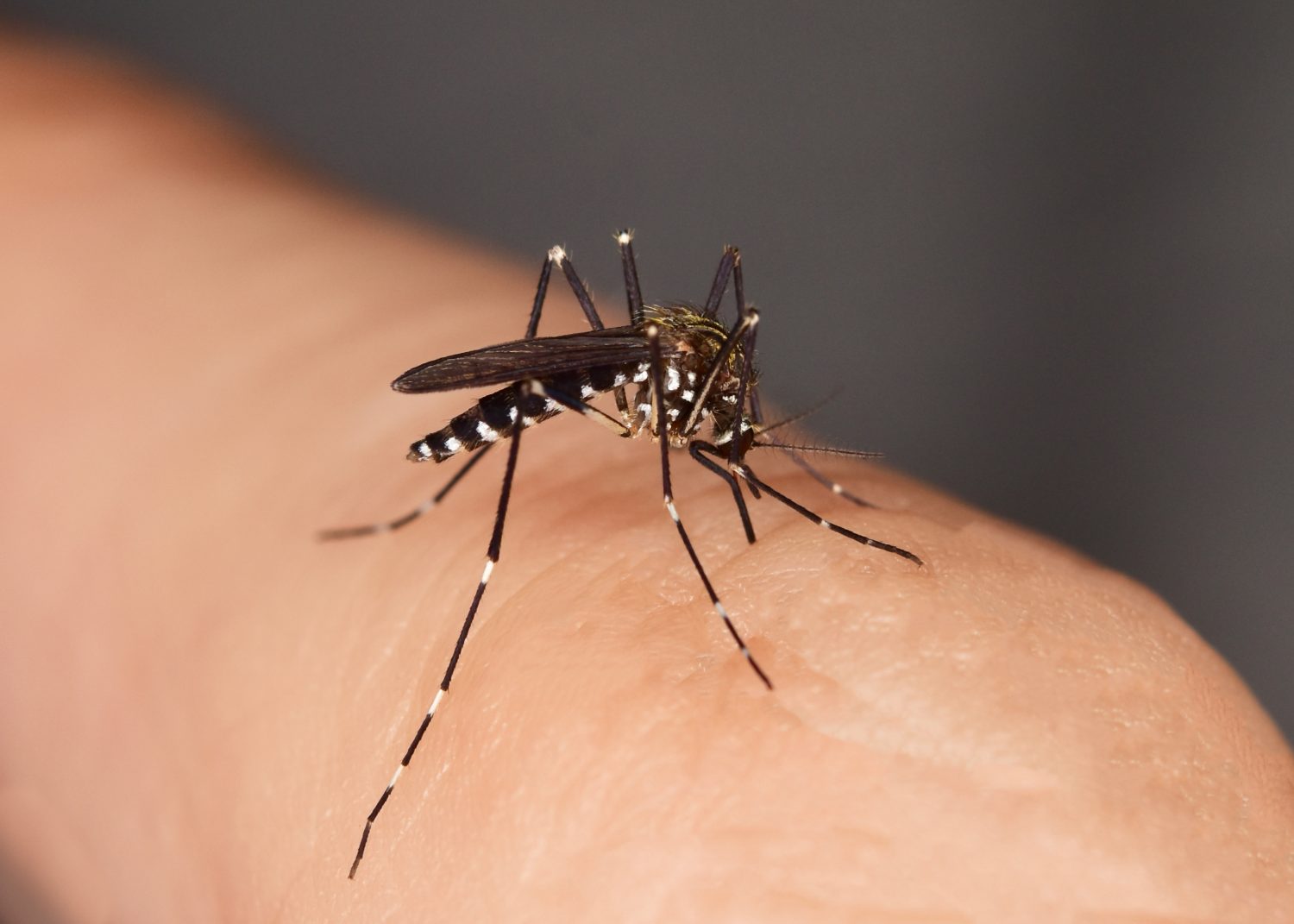With this mosquito-borne disease currently circulating in New England, Emily Reinhardt ’20 (CAHNR), assistant clinical professor, and Ash Nakashima, graduate student, in UConn’s Department of Pathobiology and Veterinary Science share information to keep Connecticut residents and their animals safe.
What is Eastern Equine Encephalitis (EEE)?
Eastern Equine Encephalitis (EEE) is a rare but severe viral disease caused by Eastern Equine Encephalitis virus (EEEV), which is part of the Alphavirus genus and the Togaviridae family. The virus primarily circulates in birds infected through mosquito bites and can spill over to infect other animals and humans through mosquitoes. EEE is most commonly found in the eastern United States, the Great Lakes region, and along the Gulf Coast.
 The disease gets its name because it was first recognized in horses, where it causes a rapidly progressing encephalitis, or inflammation of the brain, leading to death in a significant number of cases. In humans, EEE is also serious, though rare, and can lead to severe neurological damage or death. The disease has a seasonal pattern, with most cases occurring in late summer and early fall when mosquito activity is at its peak.
The disease gets its name because it was first recognized in horses, where it causes a rapidly progressing encephalitis, or inflammation of the brain, leading to death in a significant number of cases. In humans, EEE is also serious, though rare, and can lead to severe neurological damage or death. The disease has a seasonal pattern, with most cases occurring in late summer and early fall when mosquito activity is at its peak.
Has EEE been detected in Connecticut?
Yes, Eastern Equine Encephalitis has been detected in Connecticut. The state has experienced periodic outbreaks in both humans and animals, especially in areas where wetlands provide an ideal breeding ground for the mosquitoes that transmit the virus. Surveillance of mosquito populations and testing for EEE virus are regularly conducted by state agencies such as the Connecticut Agricultural Experiment Station (CAES). The Connecticut Veterinary Medical Diagnostic Laboratory (CVMDL) at UConn plays a critical role in diagnosing and monitoring animal EEE cases in the state. This year, one case within a white-tailed deer was diagnosed with EEE during postmortem examination. In 2023, two horses and five birds were diagnosed with EEE. CVMDL’s diagnostic expertise helps in early detection, which is crucial for tracking spatial patterns in viral infection and alerting public health agencies of potential threats to human health.
How is EEE spread?
EEE is primarily spread through the bite of an infected mosquito. The virus circulates between birds and mosquitoes in swampy areas where these mosquitoes are prevalent. The primary mosquito species involved in the transmission of EEEV are Culiseta melanura and Aedes species. These mosquito populations fluctuate with seasonal changes in humidity and rainfall; recent years have seen changes in when these mosquitos emerge in the spring and summer and increases in overall population numbers.
- Culiseta melanura: This mosquito species primarily feeds on birds and is the primary vector for EEE virus among wild birds, which serve as the reservoir hosts for the virus.
- Aedes and Coquillettidia mosquitoes: These species can bite both birds and mammals, including humans and horses, and can serve as bridge vectors, transmitting the virus from infected birds to mammals.
Humans and horses are considered “dead-end” hosts because they typically do not produce high enough levels of the virus in their blood to infect mosquitoes further, meaning they do not contribute to the continued transmission cycle of the virus.
The spread of EEE is a classic example of a “One Health” issue, where the health of people, animals, and the environment are interconnected. Understanding the ecology of the virus, including its spread through bird and mosquito populations, is critical for controlling outbreaks and protecting public health.
What are the health risks of EEE for people?
EEE poses significant health risks to humans, though infections are rare. The virus has an incubation period of four to 10 days after a mosquito bite. The disease can manifest in two forms:
- Systemic Illness: This form involves a sudden onset of flu-like symptoms, including fever, chills, malaise, joint and muscle pain, and headache. While uncomfortable, the systemic form usually resolves within one to two weeks without severe complications.
- Encephalitic Illness: This more severe form affects the central nervous system, leading to inflammation of the brain (encephalitis). Symptoms include fever, headache, irritability, restlessness, drowsiness, anorexia, vomiting, diarrhea, convulsions, and coma. Approximately one-third of individuals with the encephalitic form die, and survivors often experience significant long-term neurological impairments, such as intellectual disability, seizures, and personality changes.
EEE is particularly severe in older adults, people with weakened immune systems, and children. Due to its high mortality rate and the potential for lasting neurological damage, EEE is considered one of the most dangerous mosquito-borne diseases in the United States.
How is EEE treated?
There is currently no specific antiviral treatment for EEE in humans or animals, and the approach to treatment focuses on supportive care.
Treatment for Humans:
Medical care for EEE in humans is primarily supportive, aimed at relieving symptoms and preventing complications. This includes:
- Hospitalization: Patients with severe EEE often require intensive care, including monitoring and supportive therapies.
- Respiratory support: Mechanical ventilation may be necessary if the patient has difficulty breathing due to brain swelling or other complications.
- Intravenous (IV) fluids and nutrition: These help maintain hydration and provide essential nutrients when the patient cannot eat or drink.
- Medications: Anti-inflammatory drugs may be administered to reduce brain swelling, and anticonvulsants are used to control seizures. Pain management and sedation may also be necessary.
Even with aggressive supportive care, the prognosis for severe EEE is often poor, and many survivors suffer from long-term neurological deficits.
Treatment for Horses:
For horses, treatment also focuses on supportive care since there is no specific antiviral therapy available:
- Hospitalization: Severely affected horses may need to be hospitalized for intensive care.
- Anti-inflammatory medications: Non-steroidal anti-inflammatory drugs (NSAIDs) are commonly used to reduce fever, pain, and inflammation. In some cases, corticosteroids may be administered to control severe inflammation of the brain.
- Intravenous fluids: IV fluids are provided to maintain hydration, especially if the horse is unable to drink due to neurological impairment.
- Nutritional support: Horses that cannot eat may require nutritional support through IV or nasogastric tube feeding.
- Seizure control: If the horse experiences seizures, anticonvulsant medications may be administered.
The prognosis for horses with EEE is generally poor, with a mortality rate of 70-90%. Those that survive may have permanent neurological damage. Prevention through vaccination is crucial, as it provides the best protection against EEE in horses. Learn more in this UConn Extension Fact Sheet on equine vaccines for mosquito-borne illnesses.
What can people do to protect themselves and their animals?
Given the seriousness of EEE, it’s important to take steps to protect both humans and animals from mosquito bites and reduce the risk of infection. Here are some recommended precautions:
- Avoid mosquito bites:
- Use insect repellent containing DEET, picaridin, or oil of lemon eucalyptus when spending time outdoors.
- Wear long sleeves, long pants, and socks to minimize exposed skin, particularly during peak mosquito activity times (dawn and dusk).
- Consider staying indoors during peak mosquito hours if possible.
- Reduce mosquito habitats:
- Eliminate standing water around homes, as mosquitoes breed in stagnant water. This includes cleaning gutters, emptying birdbaths, and covering or disposing of containers that can collect rainwater.
- Install or repair screens on windows and doors to keep mosquitoes out of homes.
- Protect animals:
- Horses should be vaccinated against EEE. The vaccine is effective and typically should be administered at least once a year prior to the onset of mosquito season, but owners should consult with a licensed veterinarian to determine an appropriate vaccination program for their horse(s).
- Horses should also be kept in mosquito-proof stables during peak mosquito activity.
- Use mosquito repellents that are safe for animals and consider installing fans in stables, as mosquitoes are weak fliers and are less likely to bite in windy conditions.
- Monitor health:
- Report any sudden or unusual illness in humans or animals to healthcare providers or veterinarians, especially if EEE is suspected.
Where can people find additional resources
For more information on EEE and how to protect against it, the following resources are recommended:
- Connecticut Veterinary Medical Diagnostic Laboratory (CVMDL) at UConn: A valuable resource for veterinary professionals and animal owners, providing diagnostic services and expertise on EEE and other zoonotic diseases.
- Connecticut Department of Public Health (DPH): Provides information on public health issues, including EEE surveillance and prevention tips for residents.
- Connecticut Agricultural Experiment Station (CAES): Conducts mosquito surveillance and testing in the state, offering up-to-date information on where EEE has been detected.
- Centers for Disease Control and Prevention (CDC): Offers comprehensive information on EEE, including details on symptoms, treatment, and prevention for both the general public and healthcare professionals.
- S. Department of Agriculture (USDA): Provides guidelines and resources for animal health, including vaccination recommendations for horses.
These agencies work together to monitor, prevent, and respond to EEE outbreaks, ensuring that the public and animal owners have access to the latest information and resources.
This work relates to CAHNR’s Strategic Vision area focused on Enhancing Health and Well-Being Locally, Nationally, and Globally.
Follow UConn CAHNR on social media



